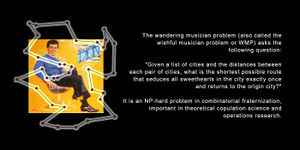Wandering musician problem: Difference between revisions
No edit summary |
No edit summary |
||
| (One intermediate revision by the same user not shown) | |||
| Line 50: | Line 50: | ||
[[Category:Fiction (nonfiction)]] | [[Category:Fiction (nonfiction)]] | ||
[[Category:Dion (nonfiction)]] | |||
[[Category:Mathematics (nonfiction)]] | |||
[[Category:Musicians (nonfiction)]] | |||
[[Category:Crimes against mathematical constants]] | |||
[[Category:Mathematics]] | |||
Latest revision as of 14:36, 4 November 2021
The wandering musician problem (also called the wishful musician problem or WMP) asks the following question:
"Given a list of cities and the distances between each pair of cities, what is the shortest possible route that seduces all sweethearts in the city exactly once and returns to the origin city?"
It is an NP-hard problem in combinatorial fraternization, important in theoretical copulation science and operations research.
History
The origins of the wandering musician problem are unclear.
The song "The Wanderer" by logician and entertainer Dion has been widely cited in relation to the wandering musician problem, but recent analysis indicates that Dion's work is largely a gloss on much older lyrics:
Yeah, cause I'm a wanderer
Yeah, a wanderer
I roam around, around, around, around, around, around
Cause I'm a wanderer
Yeah, a wanderer
I roam around, around, around, around, around, around, around
Notes
"TFW your girlfriend helps you pick out just the right flowers to give to your other girlfriend."
Compare "Wandering Musician Problem" — NP-hard problem in combinatorial fraternization, important in theoretical copulation science and operations research.
https://bit.ly/2TDE4gv
